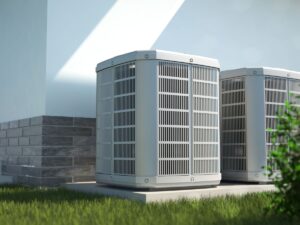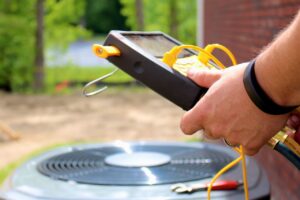Heat Pump Installation & Services in Lemon Grove, СА
Selecting the best spot for the outdoor unit of heat pump is determined by minimizing its exposure to the elements, dust, and debris. For instance, having a nearby tree shedding pods or leaves, or a dusty and overgrown garden area, can increase the risk of your Heat Pump getting dirty or blocked, leading to reduced efficiency.
Ideally, the outdoor unit should be positioned with sufficient free space on both sides to allow for proper airflow and easy access for maintenance. It should be securely mounted, either attached to a wall or on a concrete slab. To maximize efficiency, it should also be located within approximately 15 meters of the indoor air outlet.
The duration of the Heat Pump installation can vary, ranging from as little as 3 to 4 hours for a straightforward back-to-back setup (where the indoor and outdoor units are placed on opposite sides of the same wall) to a full day for more complex installations. Ducted systems may require several days, depending on the number of spaces or ‘zones’ in your home that need to be air-conditioned.

To provide you with an understanding of what to anticipate when the technicians come for the installation, here is a summary of the typical procedure for setting up a Split System Heat Pump:
- Mounting: Split System Heat Pumps consist of two distinct components: an indoor unit and an outdoor unit. The initial stage of the installation process focuses on the indoor unit. Based on the findings from the preliminary inspection, your installer of Accord Air in Lemon Grove, CA will affix the mounting bracket to your interior wall. This bracket serves as the support structure to secure your Heat Pump in the predetermined location inside your residence.
- Drilling: Once the mounting bracket is in position, the next task involves drilling a hole through your wall. This step is crucial to facilitate the connection between the indoor unit and the outdoor condenser. Specifically, the installer of Accord Air will establish:
- Electrical wiring linking the indoor and outdoor units.
- Drainage lines designed to eliminate excess moisture.
- Tubing responsible for conveying conditioned air from the outdoor condenser to the indoor unit.
- Wiring: With the hole in place for cable and pipe passage, the next step involves wiring your Heat Pump. The installer of Accord Air in Lemon Grove, CA will run all the necessary piping and wiring through the freshly drilled wall opening, securing them together using electrical tape and encasing them in protective tubing.
- Installation: Once the mounting, wiring, and piping preparations are complete, it’s time to securely position the indoor unit. Picture it as if you were connecting two robust Lego pieces – it requires a firm push to lock the indoor unit into its designated spot. After securing the indoor unit, the installer of Accord Air will connect the pipes and wiring from the previous step to the back of the indoor unit.
- Outdoor Unit: The indoor unit represents only one part of the system. Although it’s responsible for distributing conditioned air inside your home, the source of that air lies in the outdoor condenser.
Types of heat pumps
Homeowners can choose from various types of heat pumps, including air-source heat pumps, water-source heat pumps, and geothermal heat pumps. Air-source heat pumps are the most prevalent and have the potential to enhance your home’s energy efficiency.
Factors to Consider Before Installing a New Heat Pump Before purchasing a heat pump, it’s essential to take several factors into account to ensure you select the right one for your residence.
Older homes with inadequate insulation, air leaks, or low efficiency may not be well-suited for a heat pump. Consequently, you may need to improve your home’s heating and cooling systems to maximize the benefits of a heat pump installation.
Larger homes will require a correspondingly larger heat pump to achieve optimal efficiency. Smaller heat pumps may struggle to distribute heat throughout an extensive duct system. Consulting with a professional is advisable to determine the appropriate size for your property.
Preparing for a New Heat Pump Installation
Heat pumps consist of indoor and outdoor units, such as an indoor air handler. Prior to installing a new heat pump, you need to plan and prepare the external components.

Ensure that your home has adequate space for the heat pump and the necessary equipment required for installation. Establish a clear timetable for the installation process to minimize disruptions to your daily routine. Be prepared for a temporary lack of heating or cooling in your home until the installation is complete. Level the installation area and install a composite pad before positioning the new heat pump.
Disassembling the Old Heat Pump
Your heat pump contains potentially harmful refrigerants, and it is against the law to release these substances into the atmosphere. Therefore, contractors must adhere to specific EPA regulations when disconnecting and uninstalling the old heat pump. A professional technician will utilize a recovery device to safely extract the refrigerant.
Following this, the technicians will disconnect the old heat pump and establish new electrical connections for the replacement unit.
Extraction of the Indoor Evaporator
Inside your residence, the indoor evaporator coil is linked to the refrigerant lines of the heat pump system. This component is removed by skilled professionals during the installation process.
The thermostat wiring undergoes an inspection and is upgraded if necessary. Additionally, there is a valve that allows the system to switch between heating and cooling modes. The installer of Accord Air will assess whether this valve requires replacement.
The installers of Accord Air conducts comprehensive tests on the heat pump systems, evaluating their heating, cooling, and defrost functions. They also verify the functionality of the thermostat and other components.
Following successful testing, the contractors tidy up the work area and ensure that any debris is removed from your home. The space dedicated to the heat pump should appear pristine once their work is completed.
To conclude, you’ll receive a detailed walkthrough on safety measures, maintenance procedures, thermostat operations, and other essential instructions.
